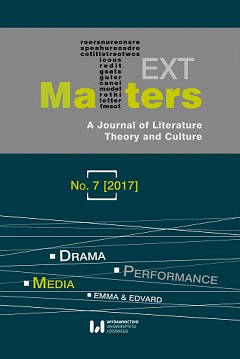Shakespeare and the Demonization of Fairies
DOI:
https://doi.org/10.1515/texmat-2017-0011Keywords:
William Shakespeare, fairies, Protestant Reformation, Thomas HobbesAbstract
The article investigates the canonical plays of William Shakespeare - Hamlet, Macbeth, A Midsummer Night’s Dream and The Tempest - in an attempt to determine the nature of Shakespeare’s position on the early modern tendency to demonize fairy belief and to view fairies as merely a form of demonic manifestation. Fairy belief left its mark on all four plays, to a greater or lesser extent, and intertwined with the religious concerns of the period, it provides an important perspective on the problem of religion in Shakespeare’s works. The article will attempt to establish whether Shakespeare subscribed to the tendency of viewing fairies as demonic agents, as epitomized by the Daemonologie of King James, or opposed it. Special emphasis will also be put on the conflation of fairies and Catholicism that one finds best exemplified in Thomas Hobbes’ Leviathan. The article draws on a wealth of recent scholarship on early modern fairies, bringing together historical reflection on the changing perception of the fairy figure, research into Shakespeare’s attitude towards Catholicism and analyses of the many facets of anti-Catholic polemic emerging from early modern Protestant discourse.
Downloads
References
Bennett, Margaret. “Balquhidder Revisited: Fairylore in the Scottish Highlands, 1690–1990.” The Good People: New Fairylore Essays. Ed. Peter Narváez. Lexington: UP of Kentucky, 1997. 94–113. Print.
Google Scholar
Bradley, A. C. Shakespearean Tragedy: Lectures on “Hamlet,” “Othello,” “King Lear,” and “Macbeth.” New York: Macmillan, 1992. Print.
Google Scholar
Briggs, Katharine. The Anatomy of Puck: An Examination of Fairy Beliefs among Shakespeare’s Contemporaries and Successors. London: Routledge, 2007 [1959]. Print.
Google Scholar
Buccola, Regina. Fairies, Fractious Women and the Old Faith: Fairy Lore in Early Modern British Drama and Culture. Selinsgrove: Susquehanna UP, 2006. Print.
Google Scholar
Buccola, Regina. “Shakespeare’s Fairy Dance with Religio-Political Controversy in The Merry Wives of Windsor.” Shakespeare and the Culture of Christianity in Early Modern England. Ed. Dennis Taylor and David N. Beauregard. New York: Fordham UP, 2003. 159–79. Print.
Google Scholar
Child, Francis James, ed. The English and Scottish Popular Ballads. Vol. 1. Mineola: Dover, 2003. Print.
Google Scholar
Daemonologie by King James the First. Ed. G. B. Harrison. London: Bodley Head, 1922. Sacred-texts.com. Web. 1 May 2016.
Google Scholar
Henderson, Lizanne, and Edward J. Cowan. Scottish Fairy Belief: A History. Edinburgh: John Donald, 2011. Print.
Google Scholar
Hobbes, Thomas. Leviathan. Ed. J. C. A. Gaskin. Oxford: Oxford UP, 1998. Print.
Google Scholar
Holinshed, Raphael. “Selections from Chronicles of England, Scotland and Ireland.” Macbeth. Ed. Sylvan Barnet. New York: Signet, 1987. Print.
Google Scholar
Hutton, Ronald. “The Making of the Early Modern British Fairy Tradition.” The Historical Journal 57.4 (2014): 1135–56. Cambridge.org. Web. 1 Apr. 2016.
Google Scholar
Johnstone, Nathan. The Devil and Demonism in Early Modern England. Cambridge: Cambridge UP, 2006. Print.
Google Scholar
Lamb, Mary Ellen. The Popular Culture of Shakespeare, Spenser and Jonson. London: Routledge, 2006. Print.
Google Scholar
Latham, Minor White. The Elizabethan Fairies: The Fairies of Folklore and the Fairies of Shakespeare. New York: Columbia UP, 1930. Print.
Google Scholar
Marshall, Peter. “Protestants and Fairies in Early-Modern England.” Living with Religious Diversity in Early-Modern Europe. Ed. C. Scott Dixon, Dagmar Freist and Mark Greengrass. Farnham: Ashgate, 2009. 139–60. Print.
Google Scholar
Murray, James A. H., ed. The Romance and Prophecies of Thomas of Erceldoune. London: Trübner, 1875. Print.
Google Scholar
Morgan, Gerald. “Sir Gawain and the Green Knight” and the Idea of Righteousness. Dublin: Irish AP, 1991. Print.
Google Scholar
Narváez, Peter, ed. The Good People: New Fairylore Essays. Lexington: UP of Kentucky, 1997. Print.
Google Scholar
Purkiss, Diane. At the Bottom of the Garden: A Dark History of Fairies, Hobgoblins, and Other Troublesome Things. New York: New York UP, 2000. Print.
Google Scholar
Purkiss, Diane. The Witch in History: Early Modern and Twentieth-Century Representations. London: Routledge, 2005. Print.
Google Scholar
Shakespeare, William. A Midsummer Night’s Dream. Ed. Trevor R. Griffiths. Cambridge: Cambridge UP, 2002. Print.
Google Scholar
Shakespeare, William. Hamlet. Ed. Harold Jenkins. London: Arden Shakespeare, 2003. Print.
Google Scholar
Shakespeare, William. Macbeth. Ed. Sylvan Barnet. New York: Signet, 1987. Print.
Google Scholar
Shakespeare, William. The Tempest. Ed. Virginia Mason Vaughan and Alden T. Vaughan. London: Arden Shakespeare, 2001. Print.
Google Scholar
Shamas, Laura. “We Three”: The Mythology of Shakespeare’s Weird Sisters. New York: Peter Lang, 2007. Print.
Google Scholar
Shell, Alison. “Delusion in A Midsummer Night’s Dream.” Shakespeare and Early Modern Religion. Ed. David Loewenstein and Michael Witmore. Cambridge: Cambridge UP, 2015. 81–95. Print.
Google Scholar
Swann, Marjorie. “The Politics of Fairylore in Early Modern English Literature.” Renaissance Quarterly 53.2 (2000): 449–73. JSTOR.org. Web. 1 Apr. 2016.
Google Scholar
Stone, Brian. “The Common Enemy of Man.” Sir Gawain and the Green Knight. Trans. Brian Stone. London: Penguin, 1974. 116–28. Print.
Google Scholar
Taylor, Gary. “Macbeth and Middleton.” Macbeth: The Norton Critical Edition. Ed. Robert Miola. New York: Norton, 2014. 296–305. Print.
Google Scholar
Thomas, Keith. Religion and the Decline of Magic. Oxford: Oxford UP, 1971. Print.
Google Scholar
Wall, Wendy. “Why Does Puck Sweep?: Fairylore, Merry Wives, and Social Struggle.” Shakespeare Quarterly 52.1 (2001): 67–106. JSTOR.org. Web. 1 Apr. 2016.
Google Scholar
Wilby, Emma. Cunning Folk and Familiar Spirits: Shamanistic Visionary Traditions in Early Modern British Witchcraft and Magic. Brighton: Sussex Academic P, 2005. Print.
Google Scholar
Wilby, Emma. The Visions of Isobel Gowdie: Magic, Witchcraft and Dark Shamanism in Seventeenth-Century Scotland. Brighton: Sussex Academic P, 2010. Print.
Google Scholar
Zika, Charles. The Appearance of Witchcraft: Print and Visual Culture in Sixteenth-Century Europe. London: Routledge, 2007. Print.
Google Scholar
Downloads
Published
How to Cite
Issue
Section
License
Copyright (c) 2017 A Journal of Literature, Theory and Culture

This work is licensed under a Creative Commons Attribution-NonCommercial-NoDerivatives 4.0 International License.













